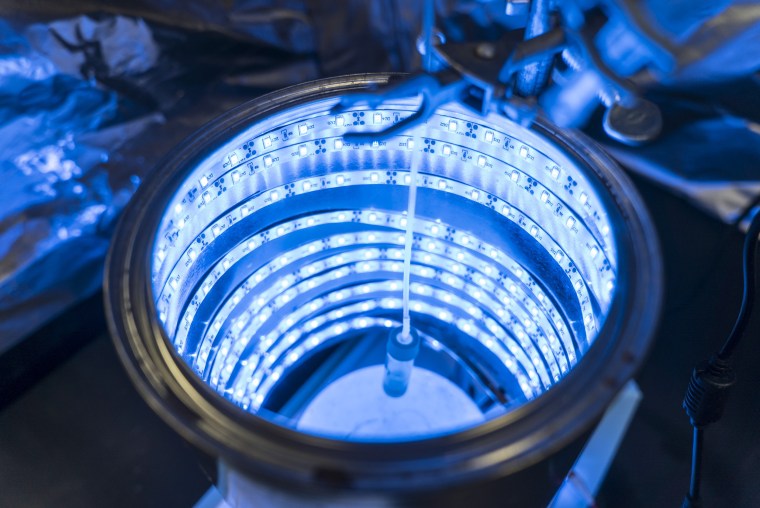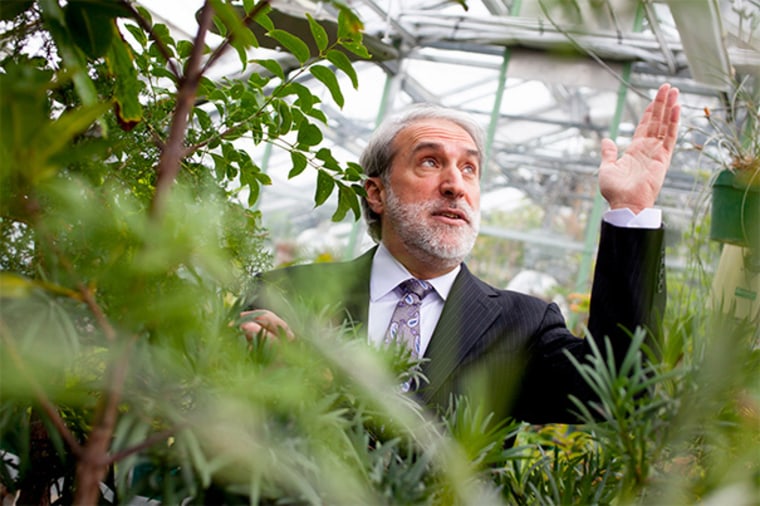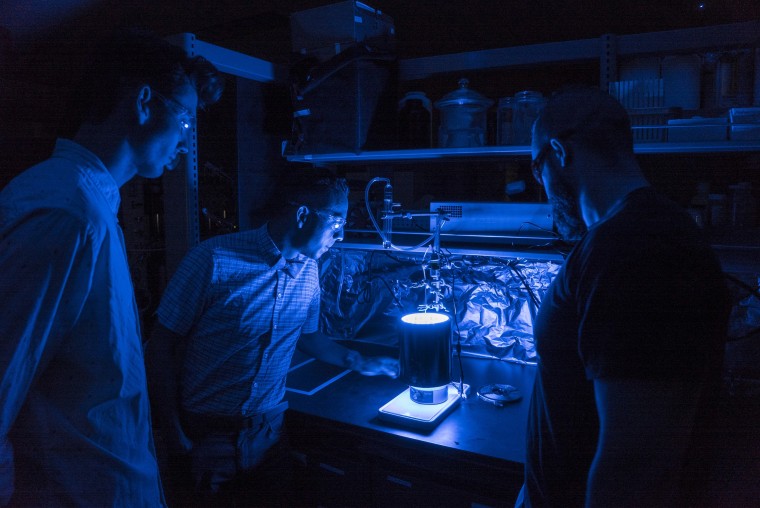It’s been a work in progress for decades, but scientists are finally close to perfecting the “artificial leaf,” a device that can turn sunlight and carbon dioxide into clean-burning fuels. The technology — a merger of biology, physics, and engineering — may one day be an important weapon in the fight against climate change as well as a vital power source, especially in developing nations.
Several research teams have approached the problem. At the University of Central Florida, chemist Fernando Uribe-Romo has developed a synthetic crystalline molecule that can trap carbon dioxide (CO2) and convert the energy from sunlight into organic compounds that can be used as fuels.
Front and center in Uribe-Romo’s lab is a device that looks like a tanning bed rolled into a cylinder. An array of LED lights mimics sunlight, giving the cylinder an eerie blue glow. The LED light interacts with a synthetic material known as a metal organic framework, or MOF. The honeycomb-like structure of the MOF traps the CO2 and acts like a “light-harvesting antenna,” Uribe-Romo says.
Making Power Plants More Efficient
It would be difficult to remove large amounts of carbon dioxide from the atmosphere using the artificial leaf technology, but it could be very useful at locations where there’s already a lot of CO2 being produced — like a coal or gas power plant, Uribe-Romo says.
“You’d have increased efficiency of the power plant because you’re getting more energy using sunlight,” he says. “And at the same time, you’re not emitting any additional carbon.”

Modern power plants typically use “scrubbing” technology to remove CO2 from exhaust gases. As Uribe-Romo envisions it, artificial leaf technology could work with existing scrubbers to further reduce CO2 emissions, and, by feeding the resulting biofuels back into the plant, it could increase the plant’s efficiency. Uribe-Romo speculates the technology could one day be used on roofs of residences, removing CO2 from the air while powering the home.
With new materials, Uribe-Romo hopes to make his artificial leaf work with wavelengths other than just blue light, making the process even more efficient. At the moment, he’s achieved an efficiency rate of about 1.8 percent, which means that it’s still less efficient than plant photosynthesis, which has an efficiency of about 2 percent to 3 percent. The research was published this spring in the Journal of Materials Chemistry A.
Splitting Water and Feeding Hungry Microbes
Meanwhile, Harvard University energy professor Daniel Nocera and his colleagues have developed what they call a “bionic leaf” — a system that uses sunlight to convert water and specially-engineered microbes into energy-dense liquid fuels.
Their device uses a photovoltaic panel to split the water into oxygen and hydrogen and then feeds the hydrogen to the microbes, which convert CO2 from the air into fuels such as alcohol. The first version of the device, which debuted in 2015, was able to produce just over 200 milligrams of fuel per liter of water — but the catalyst that they used, made up of nickel, molybdenum, and zinc, turned out to be toxic, damaging the microbes. But as they reported in the journal Science last June, a new alloy made of cobalt and phosphorus did the trick, yielding a remarkable 10 percent efficiency without harmful side effects — much higher than old-fashioned photosynthesis.
And similar to Uribe-Romo’s vision, the Harvard project has the potential to be “carbon neutral,” that is, it can create fuel without emitting any additional carbon dioxide.

Nocera says his research is “a path toward a solar fuels industry." While traditional fossil fuel systems rely on massive infrastructure and distribution networks, artificial leaf technology could be localized, which could generate household energy and help communities produce and consume only the amounts of energy they need for immediate use.
This could be a boon for the developing world, which has been a focus of Nocera's during the project. He told the Harvard Gazette in 2012 that his goal of “bringing the poor of the world their first 100 watts of energy,” would “literally change the world in a profound way for the better.”
Biofuels: A Simple Energy Storage Solution?
Research scientist Amin Salehi-Khojin and his colleagues at the University of Illinois at Chicago have developed another artificial leaf that converts sunlight and carbon dioxide into hydrocarbons, including liquid fuels. One of the benefits of the system, Salehi-Khojin says, is the ease of storage. While other renewable energy sources like solar and wind power can produce clean energy, that energy might not be available when you need it, and there’s no easy way to store it. In contrast, biofuels can be easily stored until they’re needed.
It’s “an environmentally friendly way of storing this renewable energy,” Salehi-Khojin told the Chicago Tribune.
Related: Young Inventor May Have Fix for Ocean's Plastic Problem
These systems could still be many years away from commercialization, but the researchers pursuing them see artificial leaf technology as a potentially vital tool in the urgent fight against climate change.
“It’s a big problem right now,” Uribe-Romo says. “We’re starting to see the effects of global warming — climates are changing and water levels are rising as a direct result of warming caused by human activity. So we need to address that, through many different routes. We need to reduce the carbon dioxide, reduce the emissions, and increase the efficiency of our processes.”
Dan Falk (@danfalk) is a science journalist based in Toronto. His books include The Science of Shakespeare and In Search of Time.
